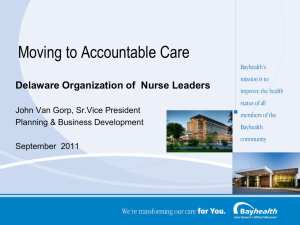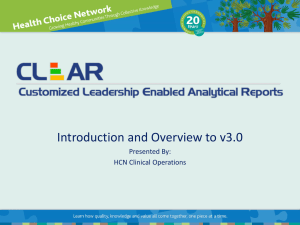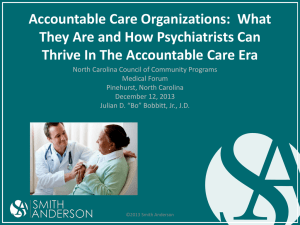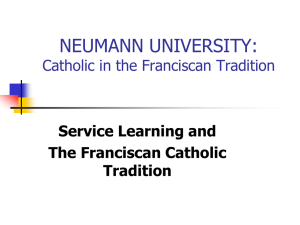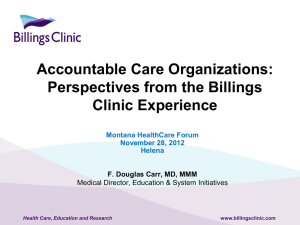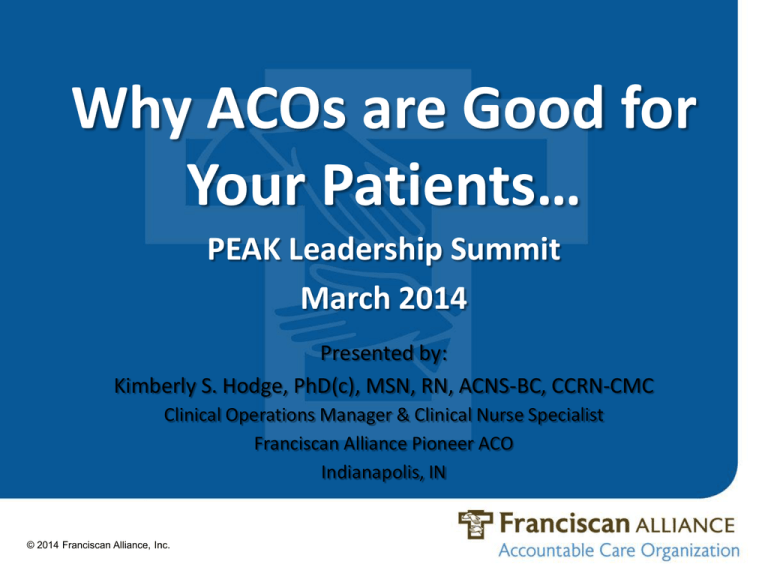
Why ACOs are Good for
Your Patients…
PEAK Leadership Summit
March 2014
Presented by:
Kimberly S. Hodge, PhD(c), MSN, RN, ACNS-BC, CCRN-CMC
Clinical Operations Manager & Clinical Nurse Specialist
Franciscan Alliance Pioneer ACO
Indianapolis, IN
© 2014 Franciscan Alliance, Inc.
Franciscan Alliance
•Has a rich history of serving local
communities for over 135 years
•Operates in 4 regions throughout
Indiana and Illinois with 13
hospitals and several healthcare
support companies
•Employs over 600 providers
(Franciscan Physician Network)
•Completed transition to the Epic
Electronic Medical Record
system during 2013 in all regions
©2013 Franciscan Alliance ACO
Carmel
Franciscan Alliance: Accountable Care Journey
ACOs originated from the Patient Protection and Affordable Care
Act (Healthcare Reform) which was signed into law on March 23,
2010. One of the goals of healthcare reform was to find ways to
deliver care that resulted in better quality at lower costs.
The Centers for Medicare & Medicaid
Services (CMS) was the first to pilot
ACOs with the Pioneer ACO program.
©2013 Franciscan Alliance ACO
3
What is an Accountable Care Organization
(ACO)?
•Groups of doctors, hospitals, and other health care providers, who
come together voluntarily to give coordinated high quality care to
their Medicare patients.
•Goal: coordinated care is to ensure that patients, especially the
chronically ill, get THE RIGHT CARE AT THE RIGHT TIME, while
avoiding unnecessary duplication of services and preventing
medical errors.
•When an ACO succeeds both in both delivering high-quality care
and spending health care dollars more wisely, it will share in the
savings it achieves for the Medicare program.
©2013 Franciscan Alliance ACO
Different Types of ACOs
•Medicare Shared Savings Program (MSSP)
•Advance Payment ACO Model
•Pioneer ACO Model
©2013 Franciscan Alliance ACO
Pioneer ACO Model (Demonstration Project)
•Designed for health care organizations and providers that are
already experienced in coordinating care for patients across
care settings.
•It will allow these provider groups to move more rapidly from a
shared savings payment model to a population-based
payment model on a track consistent with, but separate from,
the Medicare Shared Services Program.
•It is designed to work in coordination with private payers by
aligning provider incentives, which will improve quality and
health outcomes for patients across the ACO, and achieve cost
savings for Medicare, employers and patients.
©2013 Franciscan Alliance ACO
Pioneer ACO
•Payment Arrangement Options: 5 (core plus 4 alternatives)
– Varying degrees of shared savings/losses, which are capped
across performance years
– Alternatives 1 and 2 have capitation options for Part B only or
all Part A and B services
– Function like MSSP first 2 years and transition to populationbased payment approach in year 3
•Beneficiary alignment
– CMS assigns prospectively if there are 12 months of fee-forservice coverage under Part A and B
– Two-step assignment: PCP and Specialist/FQHC
©2013 Franciscan Alliance ACO
Pioneer ACO
•Interim Payment Methodology
– First 2 years: continue to receive payments under fee-for-service
program; savings/losses compared to benchmark using retrospective
reconciliation at end of each performance year
– Beginning year 3: Core and Options A and B begin receiving
combination of fee-for-service reimbursement and population-based
payments for aligned beneficiaries
• Fee-for-service paid at 50% of usual allowable fee and [opulationbased payment estimated as 50% of ACO’s expected fee-forservice costs (at 100% allowable amounts)
• Eligible for shared savings/losses but must have 3% reduction in
costs before sharing savings
©2013 Franciscan Alliance ACO
Pioneer ACO
•Benchmark Methodology
– Compared to 3-year historical claims benchmark
– Provision: limits the benchmark increase in areas of high
costs or high cost trends and increases the benchmark
more rapidly in areas of low cost or low cost trends
– Calculated retrospectively
– Recalculated in 4th performance year for remaining 2 years
of program
– Adjusted to include claims for beneficiaries no longer
aligned with ACO in the performance period
©2013 Franciscan Alliance ACO
Pioneer ACO
•Benchmark Methodology
– Choices
• Benchmark that caps expenditures at 99th percentile of national
Medicare fee-for-service Part A and Part B expenditures (reduces
variation from catastrophic claims)
• Uncapped benchmark and the requirement to purchase their own
reinsurance
– Capping done separately for ESRD and non-ESRD beneficiaries
– National reference population
• No state-specific expenditures
• Adjusted using same age, sex, and eligibility distributions across
prospectively aligned beneficiaries
©2013 Franciscan Alliance ACO
Pioneer ACO
•Trending Methodology
– ACO-specific baseline expenditure
• Base year one and base year two are trended to base year three
using trends for beneficiaries residing in the same state and having
the same age, sex, and eligibility
• Trends developed separately for trending base year one to base
year three and from base year two to base year three
– ACO-expenditure benchmark
• Trends ACO-specific baseline expenditure to the performance year
using national growth rate and absolute amount of growth, blended
50%/50%
©2013 Franciscan Alliance ACO
Pioneer ACO
•Calculation of Shared Savings/Losses
– Determined using retrospective reconciliation at the end of each
performance year against the Pioneer ACO’s benchmark for the first two
performance years
• Performance year expenditures < applicable benchmark in a given year
AND quality performance metrics are met = ACO will share in portion of
savings
• Performance year expenditures > applicable benchmark in a given year
= ACO required to pay back a portion of the losses
– Must achieve savings AND meet quality standards and other program
requirements to move to population-based payment
• CMS determines whether participating ACOs will be able to move to
population-based payment for years 3–5
©2013 Franciscan Alliance ACO
Pioneer ACO
•Calculation of Shared Savings/Losses
– Minimum savings/loss: 1%
– Savings/losses based on difference to the benchmark rather than only the
excess over the benchmark plus the minimum savings rate / minimum loss
rate (MSR/MLR)
– Potential gains/losses are greater for Pioneer ACOs under ALL program
options
©2013 Franciscan Alliance ACO
Franciscan Alliance Accountable Care Journey
In October 2011, Franciscan Alliance was awarded Pioneer ACO
status by Medicare, along with 31 other organizations across the
country. The program began January 1, 2012.
Franciscan is the only Pioneer ACO in Indiana and was officially
the first Medicare ACO in the state.
©2013 Franciscan Alliance ACO
Medicare ACO Initiatives: 2014
©2013 Franciscan Alliance ACO
Why Franciscan Alliance Chose To Participate
In An ACO
As the state’s largest Catholic-based health-care system, the
Franciscan Alliance worked diligently to become an ACO. We
recognize the vital role our hospitals, staff and partnering
providers will play in health care reform. Our goal is to become a
model for the future of health care!
©2013 Franciscan Alliance ACO
Why Franciscan Alliance Chose To Participate
In An ACO
The concept of ACOs aligns with our corporate values:
– Respect for Life: ACOs allow patients to play a more active
role in directing their own care.
– Joyful Service & Compassionate Concern: ACOs offer
better quality of care with personalized care coordination.
– Fidelity to Mission & Christian Stewardship: ACOs provide
the opportunity to significantly reduce costs associated
with duplicative testing and medical waste while benefiting
from shared savings.
©2013 Franciscan Alliance ACO
Franciscan Alliance ACO at a Glance
Franciscan Alliance (FA) Central Indiana Region (CIR) hospitals &
physicians partnered with other organizations in the Pioneer
ACO. These partners include:
• Major Health Partners
• Indiana Internal Medicine Consultants
• Fairbanks Hospital
• Rush Memorial Hospital
• WindRose Health Network
• Franciscan Visiting Nurse Service
• Advanced Healthcare Associates
©2013 Franciscan Alliance ACO
Franciscan Alliance ACO at a Glance
Participating providers include:
• Made up of over 1,000 providers across Indiana and serves
nearly 50,000 Medicare beneficiaries with 600+ Franciscan
Physician Network physicians
• Non-Franciscan Alliance affiliated health care providers,
hospitals, and other entities
©2013 Franciscan Alliance ACO
Franciscan Alliance ACO at a Glance
2014 Population:
• Approximately 50,000 fee-for-service Medicare beneficiaries
• Approximately 22,000 of those located within CIR
Medicare Status
Chronic Conditions
Aged Non-Dual
75.8%
19+
19.2%
Disabled
16.9%
15-18
10.4%
Aged Dual
6.5%
11-14
15.2%
ESRD
0.8%
7-10
21.5%
3-6
23.2%
0-2
10.6%
©2013 Franciscan Alliance ACO
Franciscan Alliance ACO at a Glance
Medicare Status Summary
Total
Population
Beneficiaries
High
Emergency
Department
Utilizers
CHF
COPD
Diabetes
Clinical Condition Prevalence
Aged NonDual
16,580
(75.8%)
293
(1.8%)
2,435
(14.7%)
4,002
(24%)
6,061
(36.6%)
Aged Dual
1,431
(6.5%)
65
(4.5%)
486
(34%)
644
(45%)
709
(49.5%)
Disabled
3,690
(16.9%)
216
(5.9%)
411
(11.1%)
1,320
(35.8%)
1,379
(37.3%)
ESRD
168
(0.8%)
42
(25%)
108
(64.3%)
85
(50.6%)
133
(79.2%)
©2013 Franciscan Alliance ACO
Focused on the Triple Aim
There are 3 main goals of an ACO, often referred to as the “Triple
Aim:”
1. Better health for the population
2. Higher-quality care
3. Lower costs of care
©2013 Franciscan Alliance ACO
Changes in Care Delivery
To meet the goals of an ACO, we must change the way we deliver
and provide care. Because patients can still go anywhere for
care, ACO providers and facilities must work together to help
coordinate care for the patients we serve.
©2013 Franciscan Alliance ACO
Changes in Care Delivery & Reimbursement
ACOs focus on improving care through change in two main areas:
1. Care delivery – the way care is delivered across different
providers along the care continuum.
2. Reimbursement
• Providers are still paid by fee-for-service.
• In order for providers to receive shared savings from
the ACO, they must be focused on AND meet quality
goals.
©2013 Franciscan Alliance ACO
Quality Measures
Quality is an important piece in the ACO. There are 33 quality
metrics that CMS uses to rate the quality of care the ACO is
providing to patients.
If the ACO does not meet certain quality metrics, it cannot
receive shared savings. Some of the quality metrics include:
•
•
•
•
•
Patient satisfaction scores
Preventive health measures
Depression screenings
Fall risk assessments
Electronic Health Records (EHR)/Meaningful Use
©2013 Franciscan Alliance ACO
Accountable Across the Care Continuum
An ACO is responsible for overseeing the cost and quality of a patient’s
healthcare across all healthcare provider settings regardless of where the patient
seeks care. This includes facilities not in the ACO.
Long Term Acute Care
Skilled Nursing Facility
Home
Primary Care Physician
Specialist
©2013 Franciscan Alliance ACO
Hospital: Inpatient & Outpatient Visits
Accountable Across the Care Continuum
TRUE coordination of care requires communication across the
entire continuum of care and at every transition, which requires
that many approaches be used. Communication vehicles and
approaches include:
•Electronic (e.g., Epic, MIE, ADVantis)
•Verbal (e.g., medication reconciliation by pharmacists prior to
hospital discharge, visit by complex care coordinator, ACO
champion and stakeholder meetings)
•Written (e.g., provider update letters)
©2013 Franciscan Alliance ACO
How do we traverse the care continuum?
©2013 Franciscan Alliance ACO
How do we traverse the care continuum?
•Complex Case Management: Registered Nurses, Advanced
Practice Nurses (NP and CNS), Social Workers, and Respiratory
Therapist
– Post-ED visit calls
– Home visits
– Provider office visits
– Health coaching
– Care coordination
– Disease management
©2013 Franciscan Alliance ACO
How do we traverse the care continuum?
•Medication Reconciliation
– Inpatient pharmacists perform prior to discharge home
– Post-acute care teams address across care settings
– Providers perform during first visit after discharge
•Advance Care Planning
– Palliative team visits beneficiary during inpatient visit and discusses
care planning options followed by documentation and communication
with the healthcare team
– Palliative team available to Complex Case Managers for consultation
•Franciscan VNS
– Preferred home health provider
– Health coaching provider
©2013 Franciscan Alliance ACO
Integrating Care Across the Continuum:
Continuing Care Networks
•Transitional / post-acute care (launched 2/2013)
– Registered Nurse (RN) facilitates beneficiary transition from inpatient to
home/post-acute setting (long-term acute care, subacute rehabilitation,
inpatient rehabilitation or home health)
•Renal (launched 8/2013)
– Adult Nurse Practitioner and Social Worker facilitate transitions across
settings for the beneficiary with end-stage renal disease
•Behavioral Health (launched 3/2014)
– Social worker facilitates transitions across settings for the beneficiary with
behavioral health concerns (e.g., depression, anxiety, addictions, etc.)
©2013 Franciscan Alliance ACO
Franciscan Alliance 2012 Results
•In 2012, via care management and care coordination programs,
the Franciscan Alliance Pioneer ACO saved Medicare over 13
million dollars
•Ranked 4th out of 32 Pioneer ACOs
•50% ($6.6 million) of those dollars were returned to the ACO,
which in turn were:
– Distributed to ACO participants, and
– Reinvested into new ACO care management programs
©2013 Franciscan Alliance ACO
Why are ACOs good for your patients?
•Quality-focused
•Cost-effective
•Optimizes communication
•Creates a continuum of coordinated, integrated care
©2013 Franciscan Alliance ACO

